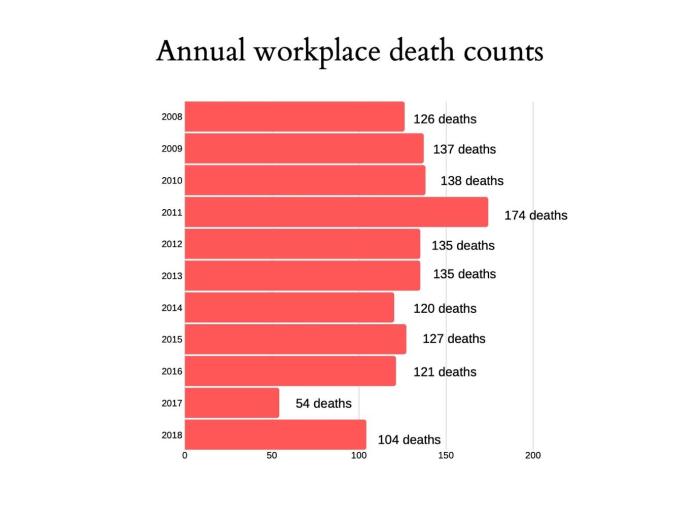The rate of work related deaths among ironworkers is – The rate of work-related deaths among ironworkers is alarmingly high, with the industry facing unique challenges and risks that contribute to this tragic statistic. This in-depth analysis will explore the occupational hazards, causes, impact, and strategies for reducing work-related deaths in ironworking, providing insights into the complexities of this issue and offering valuable recommendations for enhancing safety in the industry.
Occupational Hazards in Ironworking

Ironworking, the intricate process of fabricating, erecting, and installing structural iron and steel, is an inherently hazardous occupation. Ironworkers face numerous risks on the job, ranging from falls and electrocutions to crushing injuries and burns.
According to the Bureau of Labor Statistics (BLS), the fatal injury rate for ironworkers is significantly higher than the average for all occupations. In 2020, there were 26 fatal work-related injuries among ironworkers, a rate of 20.4 per 100,000 full-time workers.
This rate is more than six times higher than the overall fatal injury rate of 3.4 per 100,000 full-time workers.
The specific tasks and activities that pose the greatest risks to ironworkers include:
- Working at heights
- Handling heavy materials
- Using power tools and equipment
- Working in confined spaces
- Exposure to hazardous substances
Causes of Work-Related Deaths among Ironworkers
The leading causes of fatal accidents in the ironworking industry include:
- Falls from heights
- Electrocutions
- Crushing injuries
- Burns
- Struck-by incidents
These accidents often occur due to factors such as:
- Inadequate safety measures
- Lack of training
- Human error
- Defective equipment
- Poorly maintained work sites
Industry regulations and standards play a crucial role in preventing work-related deaths by establishing minimum safety requirements and guidelines for ironworking operations.
Impact of Work-Related Deaths on Ironworkers and their Families
Work-related deaths among ironworkers have a profound impact on the individuals and families involved. The emotional toll of losing a loved one in a workplace accident can be devastating, leading to grief, depression, and anxiety.
Financial consequences can also be significant, as the loss of a breadwinner can create financial hardship for families. Surviving family members may face challenges such as paying for medical expenses, funeral costs, and lost income.
Support systems and resources are available to ironworkers and their families after a work-related death. These include:
- Workers’ compensation benefits
- Employer-provided support programs
- Union-sponsored assistance funds
- Non-profit organizations that provide financial aid and counseling services
Strategies for Reducing Work-Related Deaths in Ironworking, The rate of work related deaths among ironworkers is
Reducing the rate of work-related deaths in ironworking requires a multi-faceted approach that involves industry, government, and individual ironworkers. Best practices and innovative approaches include:
- Enhanced safety training programs
- Improved safety protocols and procedures
- Regular safety inspections and audits
- Use of personal protective equipment (PPE)
- Development of new technologies to improve safety
Successful initiatives and programs that have been implemented to enhance safety in the ironworking industry include:
- The Iron Workers International Union’s (IWIU) Safety Stand-Down
- The Occupational Safety and Health Administration’s (OSHA) Ironworker Fall Protection Campaign
- The National Institute for Occupational Safety and Health’s (NIOSH) Ironworker Health and Safety Training Program
FAQs: The Rate Of Work Related Deaths Among Ironworkers Is
What are the leading causes of work-related deaths among ironworkers?
Falls, electrocution, and being struck by objects are the leading causes of fatal accidents in the ironworking industry.
What factors contribute to work-related deaths among ironworkers?
Inadequate safety measures, lack of training, human error, and industry regulations that are not strictly enforced contribute to the high rate of work-related deaths among ironworkers.
What are the emotional and financial impacts of work-related deaths on ironworkers and their families?
Work-related deaths can have a devastating emotional and financial impact on ironworkers and their families, leading to grief, loss of income, and challenges in coping with the tragedy.


